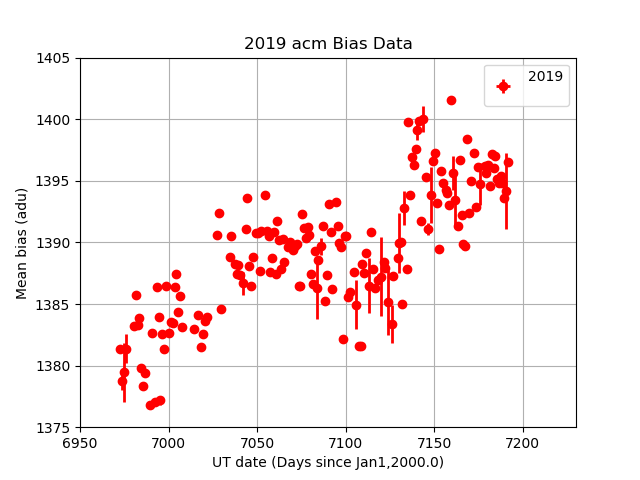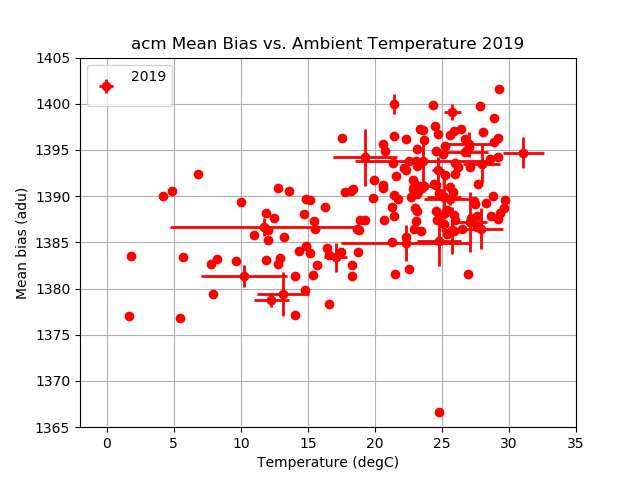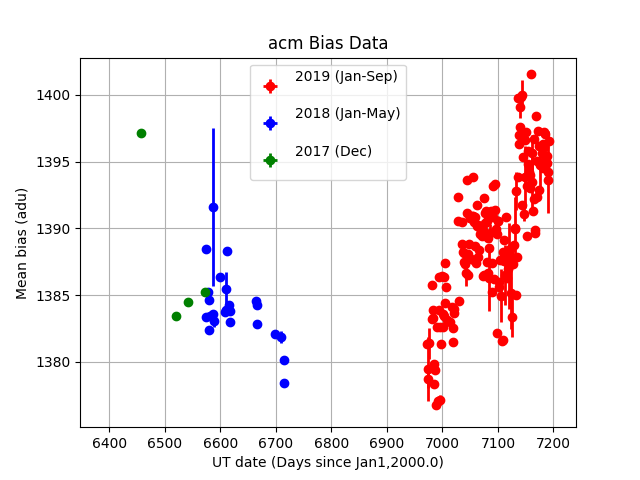In Sep2019 I revised the bias assembly software modules and analyzed the
nights with acm bias frames from 2018 and 2019.
The raw acm image reside on /hetdata/data (BaseDir)
I ran the data assembly steps on mcs:
/home/mcs/sco/ACM_BIAS_STUDY/Sep11_2019_2019/ # 2019 data sets (Jan-Sep))
/home/mcs/sco/ACM_BIAS_STUDY/Sep11_2019_2018/ # 2018 data sets (Jan-May)
/home/mcs/sco/ACM_BIAS_STUDY/Sep11_2019_2017/ # 2017 data sets (4 Dec nights)
[sco@mcs S]$ cat BaseDir
/hetdata/data
list.1 = file listing the 2019 nights on /hetdata/data
To run:
% acm_bias_for_datelist list.1 N
This took about 2 hours to run. I collect the data nto a table file format in
/home/mcs/sco/ACM_BIAS_STUDY/Sep11_2019_2019/Plot_Set_1
To plot the data, I have assembled the plot files: List.1, Axes.1, etc.....
% xyplotter List.1 Axes.1 N
I move the table files assembled in this way to
$scohtm/scocodes/Night_of_acm/BIAS/Sep2019/work1
In each pmcs processing directory (Sep11_2019_20??) we have the bias_ subdirectories
for nights where bias frame were available. I gather the BIAS_DATA_2 files into sngle
table files and make various plots in the work1/Plot_Set_20??_1 subdirectories. Finally,
I combined the the three table files (for the 3 years) I made color-coded (by year)
plots of various properties from the mean bias frames. The directories are organized as shown
below and a simple summary figure follows.
$scohtm/scocodes/Night_of_acm/BIAS/Sep2019/work1
% ls
Plot_all_1/ Plot_Set_2017_1/ Plot_Set_2018_1/ Plot_Set_2019_1/ README
% ls *
Plot_all_1:
Axes.1 B2017.parlab B2017.table B2018.parlab B2018.table B2019.parlab B2019.table Bias_all_1.png List.1
Plot_Set_2017_1:
Axes.1 B2017.parlab B2017.table GRAB List.1 S/ xyplotter_auto.pars
Plot_Set_2018_1:
Axes.1 B2018.parlab B2018.table GRAB List.1 S/ xyplotter_auto.pars
Plot_Set_2019_1:
Axes.1 Axes.2 B2019.parlab B2019.table GRAB List.1 List.2 P1_UTdays.png S/ s0/ xyplotter_auto.pars
Regular gathering of acm bias frames during RA Operation Engineering seesion was
begun in early 2019. At that time (Feb2019) it seems that the values of Ambient Temperature
(header card = "AMBTEM") were being recorded and hence we could track both the mean
bias level of the acm as well as the temperature in the dome at the time the bias frames were
gatherd. The results are summarized in the figures below.


